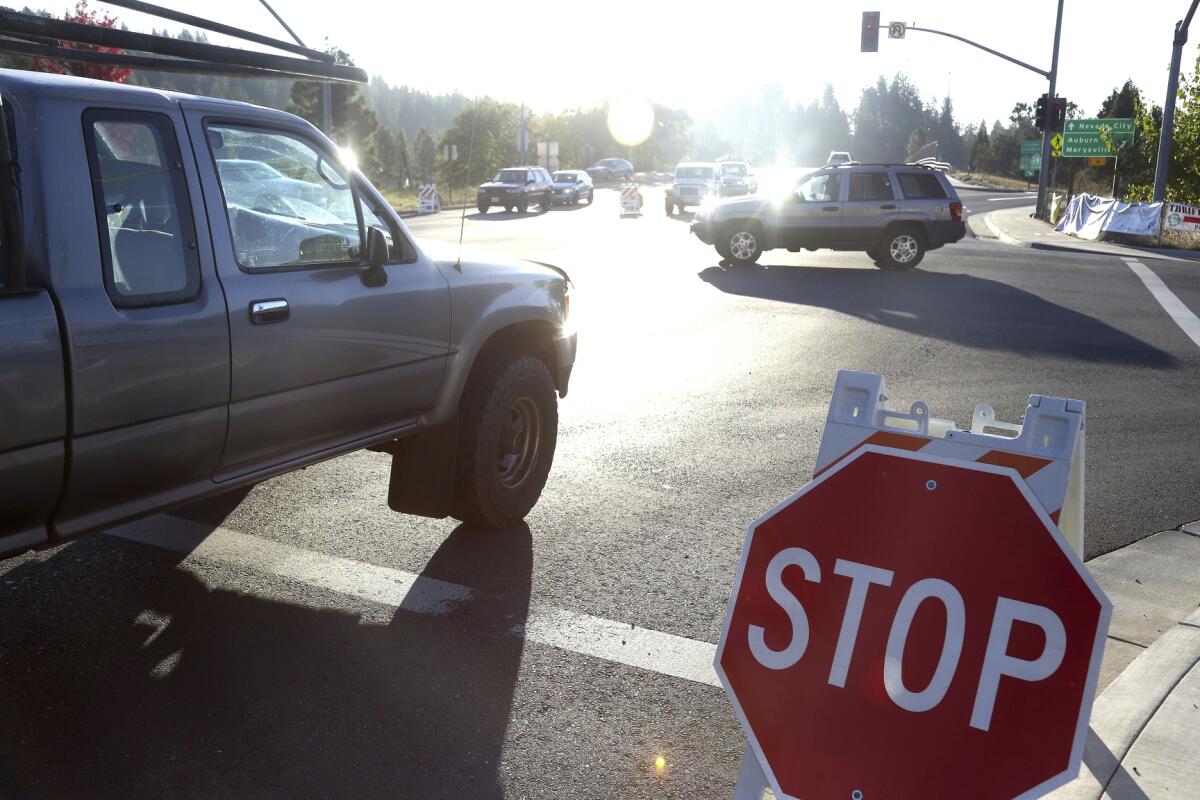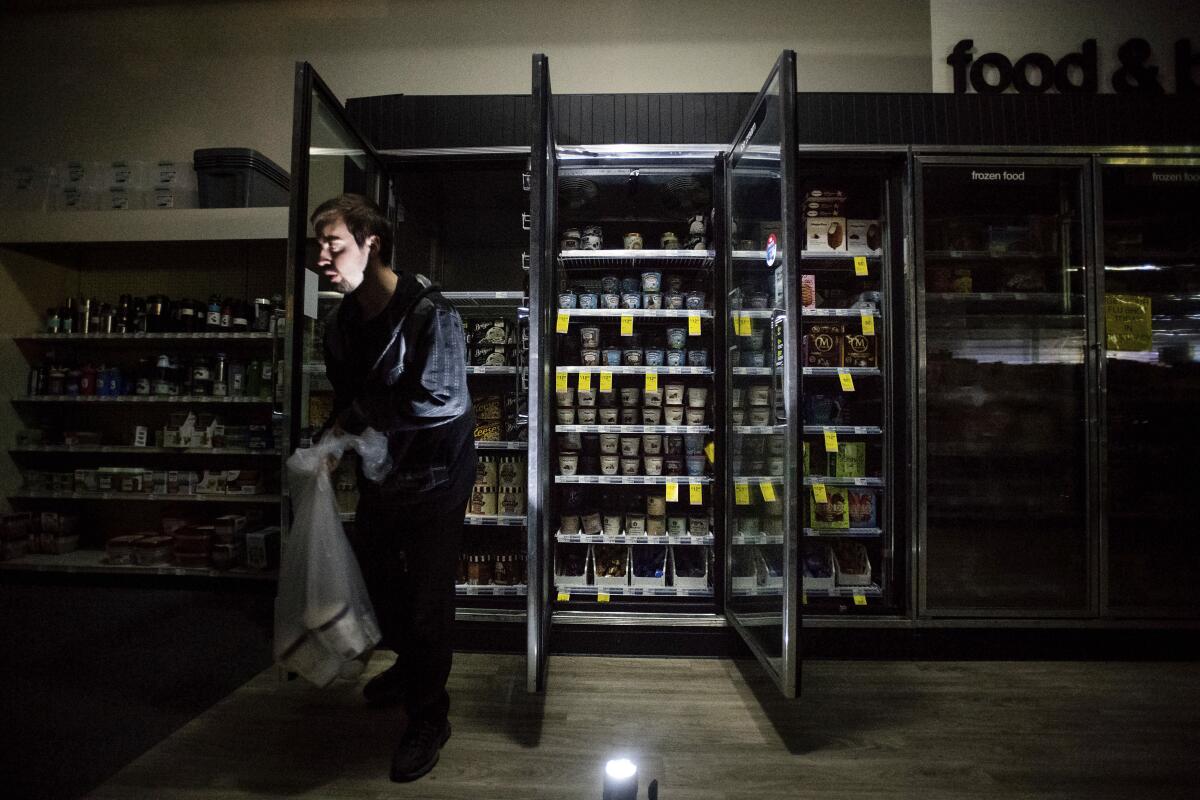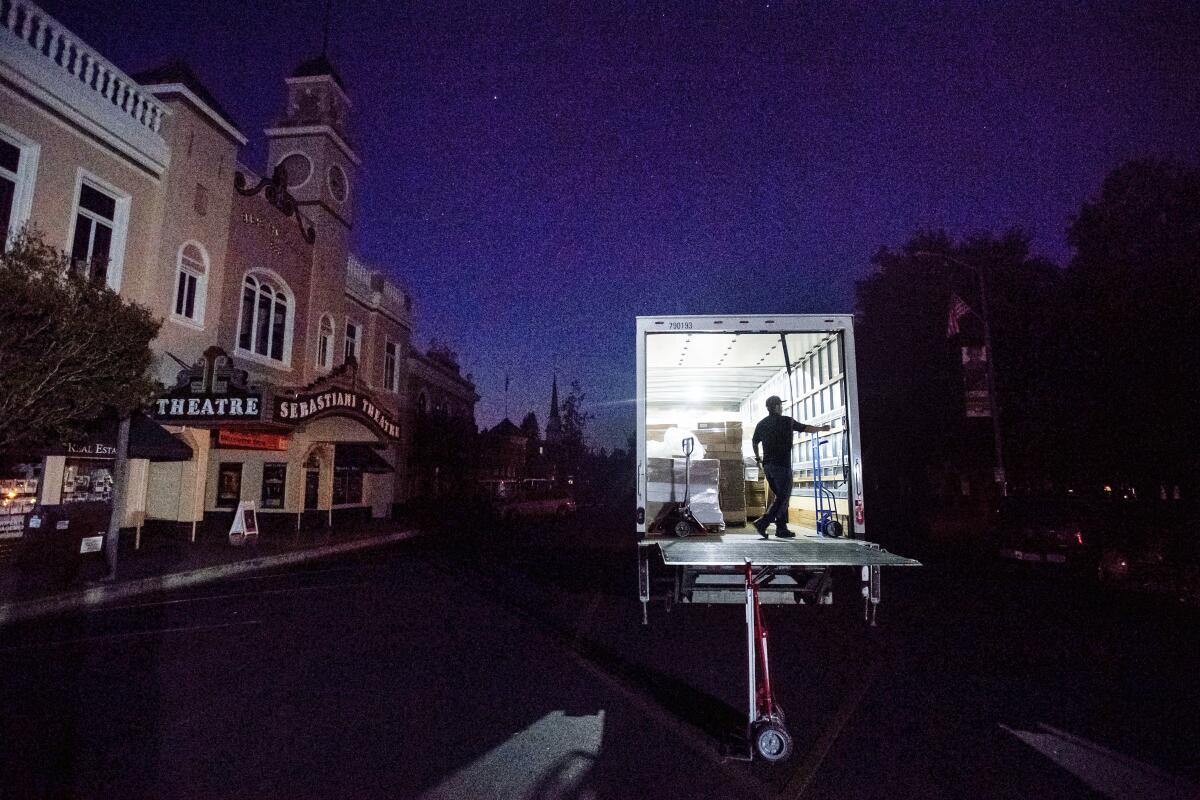Californians fume over PG&E power outage: ‘A humongous inconvenience’

- Share via
Millions of Californians could spend days without power as the state’s largest utility continues shutting off electricity in a desperate attempt to avoid wildfires sparked by windblown power lines.
The first power cutoffs, affecting about 513,000 Pacific Gas & Electric Co. customers, began shortly after midnight Wednesday in several counties around Sacramento, including Placer and Yuba. Roughly five hours later, the outages had extended to Humboldt County to the north, Marin County to the south and Nevada County to the east, according to a map provided by the utility.
The second phase of the shut-off was expected to begin about noon in areas around Silicon Valley and the East San Francisco Bay Area, but the utility said those outages would be delayed until later in the day. About 234,000 customers in Alameda, Alpine, Contra Costa, Mariposa, San Joaquin, San Mateo, Santa Clara, Stanislaus, Tuolumne, and parts of Mendocino and Calaveras counties were expected to lose power by the evening.
At a Wednesday evening news conference, PG&E officials told reporters that they had reconfigured the company’s electrical system to return service to about 44,000 customers who lost power during the first phase of shutdowns, and they were trying to return service to between 60,000 and 80,000 customers in Humboldt County after determining the area wasn’t going to experience the high winds that were previously forecast. Because of a change in the forecast, PG&E also reduced the number of residents in Kern County who would lose power from 46,000 to 4,600.
The PG&E blackouts will ultimately affect 34 counties in Central and Northern California, more than half of the counties in the state. Overall, 800,000 customers will be affected with more than 2 million people in the dark as potentially hazardous winds continue to strengthen throughout the day.

In Southern California, residents have anxiously watched how the power shutdowns have affected other parts of the state, wondering whether it was a glimpse at what was to come for them.
Southern California Edison said Wednesday that it was also considering preventive power outages. Given the strong Santa Ana winds forecast for the area, the utility said, power could be cut off to more than 173,000 customers in parts of nine Southern California counties. The outage could affect customers in Los Angeles, San Bernardino, Orange and Riverside counties, as well as areas in Ventura County and portions of Kern, Tulare, Inyo and Mono counties.
Customers of the Los Angeles Department of Water and Power will not lose power as a result of a shut-off, as the utility that serves the city does not turn off power to customers before or during wind events.
“Due to our location in a highly urbanized area with far fewer wildfire prone areas, we do not face the same threat of wildfire as many of the rural counties located in other service areas served by the larger investor-owned utilities,” LADWP said in a statement.
The move by PG&E marks the largest power shut-off to date as California utilities attempt to reduce wildfire risks amid strong winds. Equipment malfunctions have been tied to some of the state’s most destructive and deadliest fires, including last year’s Camp fire, which devastated the town of Paradise and killed 85 people, and the 2017 wine country blazes.
At the company’s evening press conference, PG&E officials acknowledged that, from their perspective, these types of massive shut-offs during fire season might be the new normal.
Sumeet Singh, vice president of PG&E’s community wildfire safety program, said customers should anticipate similar shutdowns in the future until the utility has finished its wildfire safety plan “unless the weather changes significantly and the vegetation condition and the fuel loading condition, and land and the forest management changes significantly within the state.”
Based on the latest forecasts, the utility says it expects high winds will last through midday Thursday, with peak winds reaching 70 mph through Thursday morning. Gusty winds and low humidity across much of the northern section of the state prompted the National Weather Service on Wednesday to issue an extreme fire weather warning.
Once the fire weather subsides, PG&E will inspect and test the grid both electronically and with on-site crews before restoring service. That could take up to five days, a company official said.
PG&E has 6,300 ground personnel and several helicopters to perform that work, but for safety reasons, can only do safety inspections during daylight hours, according to the company.
“The safety of our customers and the communities we serve is our most important responsibility, which is why PG&E has decided to turn power off to customers during this widespread, severe wind event. We understand the effects this event will have on our customers and appreciate the public’s patience as we do what is necessary to keep our communities safe and reduce the risk of wildfire,” said Michael Lewis, PG&E’s senior vice president of electric operations.

The state’s fire protection agency has not studied whether the power cutoffs have had any effect on the number of wildfires that California has seen, the agency’s spokesman said.
The California Department of Forestry and Fire Protection is not part of the decision-making process when a utility is trying to determine whether to cut power, said Cal Fire spokesman Scott McLean.
“We’re like everybody else — we adapt accordingly,” McLean said. “These power outages aren’t hampering our response capabilities. We’re making sure we have the power and logistical support we need to keep functioning.”
McLean said he couldn’t speak to whether Cal Fire leaders felt the outages were helpful, because the agency hasn’t studied the matter, but he did want the public to remember one particular bit of information.
“Ninety-five percent of all wildfires are human-caused, and that doesn’t mean arson by any means,” he said, adding that people needed to be mindful of any activities that could produce a spark, from mowing the lawn to using chains to tow a car.
The power shut-offs have generated backlash, with some residents saying they create a whole new set of dangers as they try to watch for news about fires. There is also concern about those with health issues who rely on electrically powered medical equipment to stay alive. Critics worry that communications and evacuations will be hampered if the power is out, especially if traffic signals don’t work and cellphone service is affected.
“I think this is a tacit admission that they recognize their liability for huge wildfires we’ve had and that their grid has a lot of deficiencies,” James Moore, an attorney from Auburn in Placer County, said of the widespread outages.
Moore, 35, said he realized the power had been cut off when his CPAP machine stopped working overnight. Moore and his wife, Kristen, tried to prepare as best they could with limited notice, filling cars with gas and buying ice to keep refrigerated items cold, he said.
Their home has electric appliances, so cooking will be limited to a propane grill they use for camping. And because an electric pump brings water to the property, the couple also will not have running water.
“I wish they would have been more transparent in informing people earlier of their plan to do these kind of power shut-offs,” Moore said. “I recognize the weather is not something they can predict very far in the future, but the fact they’re turning off power in 34 counties is a humongous inconvenience, to say the least.”
Lilli Heart, 73, a jeweler who works out of her home crafting pendants, bracelets and other decorative objects out of Swarovski crystals, lost everything when the Camp fire swept through Paradise 11 months ago. She’s back on her feet, living in a lakefront home in Cottonwood, but on Wednesday, she was struggling to maintain a positive outlook after her power was cut off.
At first her Facebook posts were upbeat, even cheerful.
“Ok power now down glad I just got my bowl of ice cream eating by flashlight,” she wrote and signed off with a heart emoji.
Eleven or so hours later, she was still mostly holding her own: “The wind is certainly strong today,” she posted to Facebook. “My hummingbirds are struggling to get to their feeders. They are freaking out. Cold here too. So with no electricity or propane I used what was left to get some hot water out of the tap the last of it to make more nectar for them.”
And another heart.
By lunchtime, though, all bets were off. She’d swung by the vet to pick up medication for her ailing rescue cat and his cancerous thyroid. She headed to the market to pick up groceries, knowing the place was cash-only and all she had on hand was $15. She answered her cellphone and let loose on PG&E and its crippled electrical grid.
“I’m really mad at them,” Heart fumed. “We’ve had high winds in California for years and they’ve never shut down the power. It’s unconscionable. They’re talking about possibly six days. I have nine orders today. I can’t fill my orders. And that’s just me. Some people are on oxygen. I think the governor needs to step in and do something.”

Online chat boards dedicated to monitoring police and fire activity in rural counties were filled with residents asking for help and advice. Some said the short notice of blackouts had caused turmoil as people searched for open gas stations to buy fuel for generators and rushed to buy batteries and other supplies.
Brady Miller, a resident of Red Bluff, about two hours north of Sacramento, said he barely had cell service and no way to charge his phone, lamenting he had only flashlights and canned goods to get through the power outage.
“It sucks,” he said. “Twenty-four-hour notice gave panic to our community.”
Angie Sheets of El Dorado Hills noticed that generators were flying off the shelves at Costco as she shopped for groceries earlier in the week. Considering the nearly $1,000 worth of food she planned to purchase and the imminent power outage, Sheets said, she called her husband to talk about buying one for their home.
“By the time I had done that, the last big generator was gone off the shelves,” she said.
Her husband, a law enforcement officer, found a generator at a Costco in Rancho Cordova and paid about $600 for it. On Tuesday night, they filled up their bathtubs with water, unsure whether the toilets would flush without electricity. Sheets went to Safeway to pick up more bottled water and said a line of cars snaked around the gas station parking lot.
“In this particular area, they did say we could lose power for up to seven days,” Sheets said. “I think that’s what’s making people on edge, the fear of the unknown and wanting to be safe for your family.”
Millions of Californians could spend days without power as the state’s largest utility continues shutting off electricity in a desperate attempt to avoid wildfires sparked by windblown power lines.
Families in Rocklin, a city in Placer County about 20 miles from Sacramento, went to sleep Tuesday night unsure whether schools would be open in the morning or whether they would have electricity.
Ultimately, power was cut to homes in parts of the city, but the campuses in the Rocklin Unified School District opened as scheduled. Residents flooded a nearby Starbucks that still had power early Wednesday to charge electronics and buy a hot cup of coffee.
About an hour away in Placerville, the power went off around 3 a.m., leaving many angry and scrambling for supplies.
Placerville Hardware owner Albert Fausel had his store’s cash registers running on a generator at midmorning as customers roamed the aisles in darkness, loading up on flashlights, oil lamps and batteries.
Some lamented that the utility had shut off power amid only a slight breeze.
“There isn’t a tree moving right now because of the wind, and we don’t have power,” Tod Pickett said as he bought battery-powered lamps from the hardware store. “And they are telling us there’s a hurricane.”
State Sen. Bill Dodd (D-Napa) said people in his district understand that power shut-offs may save lives and prevent the kinds of wildfires that have devastated the community, but he expressed frustration over the outages before wind speeds had even picked up.
“Now for 12 hours the power has been shut off, and there’s no justification based on the wind speeds that we have anywhere in Napa County,” Dodd said. “It’s totally acceptable for the power to be shut off when people are in danger and a fire could start. My constituents get that. But this is beyond belief.”
Daniel Barnes, who has lived in Placerville for 11 years, shook his head as he stood downtown, where many shops and restaurants were closed. Typically, the area is packed with tourists and shoppers. But on Wednesday, the only major activity was traffic lights blinking.
“This is the politics of power generation,” Barnes said. “It’s devastating to the economy of a small town like this.”
Lake County Sheriff Brian Martin said although his community of about 65,000 has lost power, he feels better prepared for outages this week than he has in prior shut-offs, when some criticized PG&E for failing to communicate with local officials and emergency responders.
Martin said the county is working closely with PG&E to locate residents with sensitive medical needs and those who may need power to survive. Schools closed in anticipation of the outages, and hospitals, county courthouses, government offices and traffic signals are operating off generators, he said.
“It’s having a significant impact on us as a community up here,” Martin said. “I think we’re as prepared as we can be.”
Denise Boldway, owner of Blossoms Florist in Eureka, said the outage launched the city into pandemonium.
“You couldn’t get gas last night, and there was a two-hour wait at the grocery store to check out. Stoplights are out today, and traffic is backed up in every direction,” she said.
Still, she says, she fully supports PG&E’s decision to cut the power.
“The winds are 30 to 45 mph today and you don’t even want to walk outside,” she said. “I feel like it’s totally justified.”
Outages forced the closure of several schools across Northern California, including UC Berkeley, which canceled classes after it was notified by PG&E that power would be cut for up to 48 hours, according to a statement by university officials.
The California State University system also had to cancel classes at Sonoma State and Humboldt State, which together have about 17,000 students.
Gov. Gavin Newsom said Wednesday that he supports the utility’s decision to take “proactive measures” in the face of severe wildfire conditions. But he again lashed out at PG&E leadership for not making more efforts to prepare the company’s infrastructure for fire danger.
“They’re in bankruptcy because of their terrible management, going back decades,” Newsom said at a housing-related event in San Diego. “It’s time for them to do the right thing. Get out of bankruptcy and get this system into the 21st century.”
Times staff writers Joseph Serna, James Peltz, Alejandra Reyes-Velarde, Anita Chabria, Melody Gutierrez and John Myers contributed to this report.
More to Read
Sign up for Essential California
The most important California stories and recommendations in your inbox every morning.
You may occasionally receive promotional content from the Los Angeles Times.
















